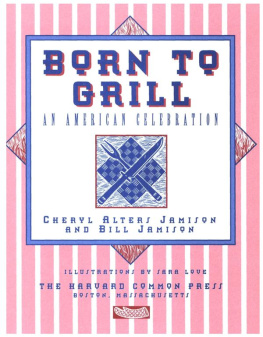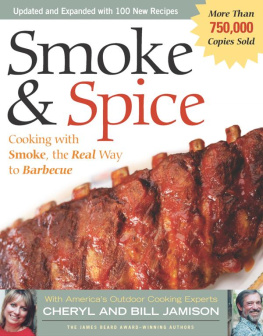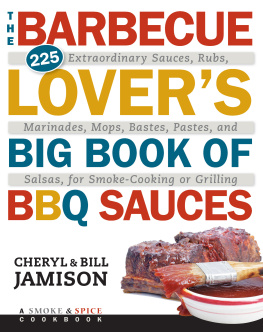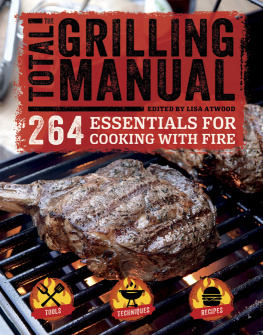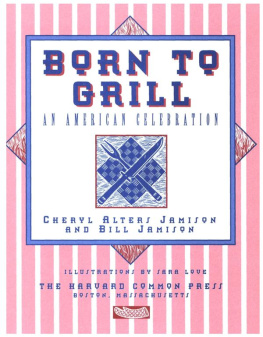Jamison Bill - Born to grill : an American celebration
Here you can read online Jamison Bill - Born to grill : an American celebration full text of the book (entire story) in english for free. Download pdf and epub, get meaning, cover and reviews about this ebook. City: Boston, Mass, year: 1998, publisher: Harvard Common Press, genre: Home and family. Description of the work, (preface) as well as reviews are available. Best literature library LitArk.com created for fans of good reading and offers a wide selection of genres:
Romance novel
Science fiction
Adventure
Detective
Science
History
Home and family
Prose
Art
Politics
Computer
Non-fiction
Religion
Business
Children
Humor
Choose a favorite category and find really read worthwhile books. Enjoy immersion in the world of imagination, feel the emotions of the characters or learn something new for yourself, make an fascinating discovery.
- Book:Born to grill : an American celebration
- Author:
- Publisher:Harvard Common Press
- Genre:
- Year:1998
- City:Boston, Mass
- Rating:3 / 5
- Favourites:Add to favourites
- Your mark:
- 60
- 1
- 2
- 3
- 4
- 5
Born to grill : an American celebration: summary, description and annotation
We offer to read an annotation, description, summary or preface (depends on what the author of the book "Born to grill : an American celebration" wrote himself). If you haven't found the necessary information about the book — write in the comments, we will try to find it.
Born to grill : an American celebration — read online for free the complete book (whole text) full work
Below is the text of the book, divided by pages. System saving the place of the last page read, allows you to conveniently read the book "Born to grill : an American celebration" online for free, without having to search again every time where you left off. Put a bookmark, and you can go to the page where you finished reading at any time.
Font size:
Interval:
Bookmark:
T HE H ARVARD C OMMON P RESS
535 Albany Street
Boston, Massachusetts 02118
www.harvardcommonpress.com
Copyright 1998 by Cheryl Alters Jamison and Bill Jamison
Illustrations copyright 1998 by Sara Love
All rights reserved.
No part of this publication may be reproduced or transmitted in any form or by any means, electronic or mechanical, including photocopying, recording, or any information storage or retrieval system, without permission in writing from the publisher.
Printed in the United States of America
Printed on acid-free paper
The ISBN for Born to Grill is now 1-55832-291-4.
It was originally published with the ISBN 1-55832-112-8.
Library of Congress Cataloging-in-Publication Data
Jamison, Cheryl Alters.
Born to grill : an American celebration / by Cheryl Alters
Jamison and Bill Jamison ; illustrations by Sara Love,
p. cm.
Includes index.
ISBN 1-55832-111-X (hardcover)ISBN 1-55832-112-8 (paperback)
1. Barbecue cookery. 2. Cookery, American. I. Jamison, Bill. II. Title.
TX840.B3J35 1998
641.5'784dc21
Special bulk-order discounts are available on this and other Harvard Common Press books. Companies and organizations may purchase books for premiums or for resale, or may arrange a custom edition, by contacting the Marketing Director at the address above.
C OVER DESIGN BY N IGHT & D AY D ESIGN
T EXT DESIGN BY K ATHLEEN H ERLIHY -P AOLI , I NKSTONE D ESIGN
F RONT COVER PHOTOGRAPH BY E LLEN S ILVERMAN
A UTHOR PHOTOGRAPHS BY K ITTY L EAKEN
T EXT ILLUSTRATIONS BY S ARA L OVE
10 9 8 7 6 5 4 3
For Riley Jamison Neale,
our grandson who was born to grill
almost the same day we finished
Born to Grill
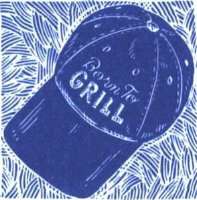
To several generations of backyard cooks in Illinois and Texas, our parents included, who fired up our initial enthusiasm for grilling.
To chefs, cookbook authors, food scientists, and other culinary professionals who gave us advice or inspired our efforts in other ways: Marlys Bielunski, Arch and Shirley Corriher, Jennifer Cuccia, Robin Kline, Harold McGee, Mark Miller, Stephan Pyles, Chris Schlesinger, and John Willoughby.
To friends who opened their personal cookbook libraries to us: Rob Coff-land, Craig Smith, and Wayne Whit worth.
To archivists and librarians who aided our research at Kraft Foods, the Girl Scouts of America, the Schlesinger Library of Radcliffe College, Sunset magazine, and Texas Woman's University.
To our cheerful local suppliers at The Forager, Kaune's, Kokoman Circus, and The Market Place, who came through for us no matter how weird the request.
And most especially to publisher Bruce Shaw and editor Dan Rosenberg for years of support and friendship that have always kept us fired up.
Americans didn't invent outdoor cooking, but they can take much of the credit for making it fun. People started cooking outdoors even before they had an indoors, as soon as they tamed flame, and the advance marked one of the earliest and most significant steps ever in human social development. For many millennia, fireside cooking remained the only kind on earth, but it was more of a routine necessity than a pleasure, at least until the victuals reached the mouth.
By the time most people around the globe had successfully moved the cooking fire inside, with huge sighs of self-satisfaction, Americans took the old practice out the back door and made it into a party. They discovered that you could keep the chores in the kitchen and play with the flame in the forest, at a park, or on the patio.
They went to the woods originally. With inspiration from their Native American neighbors, early English, French, and Spanish colonists in the New World found they could tenderize and flavor wild game and other meat through slow smoking over smoldering wood embers. They improvised several methods of doing it, but typically they cut a few trees, dug a long pit in the ground, filled the trench with logs, and cooked whole animals overnight above a smoky fire. The Spanish named the technique barbacoa, a term that transmuted in English into barbecue.
One of Martha Stewart's predecessors proclaimed the idea perfect for entertaining and it became the party of choice long before Democrats and Republicans existed. From New York City to the Texas frontier, the young country staged barbecues to celebrate weddings, births, religious revivals, and anything else worth a good shout. Margaret Mitchell stoked up one in Gone With the Wind to bring together Scarlett O'Hara and Rhett Butler, and the sure sign of an American institution, George Washington probably slept at one.
The love of outdoor feasting survived and thrived through the following centuries, though the original style of cooking gradually died out in most areas except the South and Midwest. When Americans began flocking to cities and suburbs, they left behind their woodsy ways, including the old slow-smoked barbecue. They couldn't very well dig up their streets to make underground pits or cut the trees in their lawns for log fires. Longing for a backyard and balcony alternative, urban Americans jumped into charcoal grilling- as soon as the fuels and tools started becoming widely available in the 1940s. In the national euphoria following the end of the Great Depression and World War II, the new method of outdoor cooking took off quicker than a Hollywood scandal.
Fans even called the craze "barbecue," despite vast differences from the historical version, because it offered the same combination of flavor and fun in an open-air setting. In direct contrast to the old art, grilling starts with small, tender ingredients and cooks them quickly over high heat. The methods and results couldn't be more different between the two techniques, but each is naturally suited to the outdoors and boasts the same kind of pleasures, particularly of the palate. Whether the succulence comes in the form of barbecued ribs basted in a pit for hours or a juicy steak seared on a grate in minutes, both ways of cooking bring out the best in America's favorite foods.
In the years since the first grills (or "barbecues") popped up across the country, the patio passion has spawned a huge industry. Within five decades, by the 1990s, more than 80 percent of American households owned at least one grill and some 12 million people bought a new one each year. Charcoal manufacturers sold about 800,000 tons of briquettes annually, twice as much as during the 1960s, even though gas grills were rapidly challenging charcoal models in popularity.
With success came marketing departments, as in all industries, and they in turn drove the introduction of new products. The simple, cheap grills of yesteryearbarely more than a cooking grate on spindly legsevolved into sophisticated appliances capable of doing anything short of a back rub. Virtually all grills today can roast a turkey or bake a potato, and many of them can simmer beans, steam broccoli, and fry fish, attributes intended to broaden the appeal of the equipment and encourage aficionados to upgrade to fancier models. Compared to their counterparts from the past, every one of these modern all-purpose outdoor cookers looks and operates like a dream machine.
Therein lies the rub. Contemporary grills are so versatile and easy to use that they've led us to neglect real grilling, an earthy and primal process based at its best on human touch rather than mechanical prowess. Too often these days we think we're grilling just because we're using a grill. In fact, much of the time we're actually cooking the food in quite a different way and losing much of the grill flavor that brought us into the backyard originally, a matter that we address more fully in the next chapter.
Next pageFont size:
Interval:
Bookmark:
Similar books «Born to grill : an American celebration»
Look at similar books to Born to grill : an American celebration. We have selected literature similar in name and meaning in the hope of providing readers with more options to find new, interesting, not yet read works.
Discussion, reviews of the book Born to grill : an American celebration and just readers' own opinions. Leave your comments, write what you think about the work, its meaning or the main characters. Specify what exactly you liked and what you didn't like, and why you think so.

